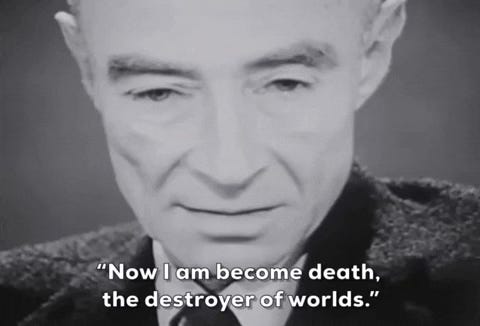It’s Paris Fashion Week. What’s the Point Again?
On Schiaparelli’s alien couture and cinematic love letters.
Violets is now Left On Red and you’re reading Starting Point, where I look beyond nature and love and into the living, breathing world around us for poetic inspiration.
Today’s Poem
I’ve forgotten the difference between memory and implant, something that was mine, the other forced on me one pixel-inch at a time, the glittering carrot dangling and I didn’t notice it getting closer getting bigger swallowed me whole and now I’m inside. I didn’t think to scream get it out get it out, instead my genes inherited a whisper, named it “dream”, now my greatest fear is that my frontiers are behind me and heaven was the shape of 2007 when I still saw you for you, not a bubble on my screen, all body, just a thing to hold onto and now in front of me there’s a shape with voices, and thoughts, and hollow imitations, rows I couldn't pick out from the line. There was once a man who dreamed of living on Mars. And so many girls and mothers and machines dreaming of beauty, preferring instead to know that they are real. Their frontiers are what we call freedom. Turns out I'm mere parts trying to be human and I passed that threshold long ago, the first time I saw a thrill, dodged it, named it “regret”, then called it: the simulation, is it I?
6 foot tall fashion models walk down the runway all somber in sculpted gowns with the tonally contrasting yet familiar sound of something blaring in the background. It doesn’t take more than a few seconds to register: it’s the Top Gun soundtrack.
In comes an Alien reference, a dash of Oppenheimer. You wonder what the heck is happening. Your first thought might be: wow. The second: I don’t get it.
Welcome to the fluffiest time of the year. It’s Paris Couture Fashion Week.
Today I will proceed to live my fashion enthusiast dreams vicariously through this newsletter by presenting not-a-review, kind of like Juliette Has A Gun’s not-a-perfume, though the goal here isn’t to reach icon status but simply to waft an air of poetic surprise and delight your way.
The target of my not-a-review today is Parisian house Schiaparelli, whose Spring/Summer 24 couture show was titled “Schiaparalien”.
A brief fashion history lesson for those of you who are here for the poetry and not the fashion: Schiaparelli was one of the iconic 20th century fashion brands started by a woman—Elsa was her name—and the house’s highlight reel includes “inventing”shocking pink way before Valentino and Barbie rocked 2023 with it, collaborating with some of the most popular artists of her time like Salvador Dali and bringing together the worlds of fashion and art, and injecting playful surrealism into clothes that had been otherwise a force for female revolution starting in the 20th century in a much more practical sense and almost never in the strange and uncomfortable sense. Our clothes are pretty much only moving in the direction of more and more comfort, from the death of corsets to the invention of spandex to Lululemon as daily uniform.
A few weeks ago, I told the story of how I became a reader after embarrassingly only reading books I deemed Useful and Productive for over a decade. Another way I’ve changed: When I was a kid, I caught my very first glimpse of couture on Fashion Television and remember thinking: Who would wear that? Unless it was a Disney princess gown or Cindy Crawford, I wasn’t interested. When I later decided to study fashion, I aligned myself to the perpetration of the “wearable”, dismissed couture as a spectacle for the elite.
Recently, I’ve started to question my own taste: what do I even mean by wearable? Practically, is it something easy to put on, that feels good against the body, that suits my lifestyle needs? Or is there a layer of social conditioning beneath that? Is wearability about palatability? About conventions and norms? By subjecting myself to standards of flattery and belonging, am I both more human and less myself? Why does this dichotomy seem so easy to other people? Am I just more alien than I had once believed and asserted myself to be?
In 2024, Schiaparelli operates under the helm of its creative director, Texan-in-Paris Daniel Roseberry. And the label has really popped off: Schiaparelli used to be taught only in the context of fashion history, not as a current brand to pay attention to and certainly not part of the 21st century fashion zeitgeist. It now shows on the first day of couture week, basically setting the mood as the unofficial opening act of the grandest recurring display of craft and beauty in the world. Elsa Schiaparelli would probably be proud. Long live her penchant for making a statement.
Last season, we saw Kylie’s lionhead dress, Doja Cat adorned with 30,000 red Swarovski crystals, and a show inspired by Dante’s Inferno.
This week, we got J. Lo donning a coat made of 7,000 white rose petals preserved with sugar water, and a mini Euphoria reunion with Zendaya and Hunter Schafer looking not fashion-as-usual in black.
(The show starts with whatever whoever is sitting in front row is wearing.)
I wasn’t there, obviously. But the show itself was a whole “Matrix meets Westworld” (Joelle Diderich for WWD) vibe, and there was both a Mother and a Baby made of upcycled technology remnants from before 2007: old flip phones, wires, microchips, calculators. And then there were of course sculptures as gowns. If you want to read fashion’s back row perspective, a.k.a. a real review:
’s A Baby for the Ultrarich.So what does a movie about a cocky fighter pilot have to do with outdated technology and artificial babies?
Because I wasn’t there and therefore have none of the pressures of the fashion press (unfortunately and fortunately) (because if I did, I’d do Maison Margiela, Giorgio Armani Privé, and Robert Wun, too), I had the pleasure and challenge of trying to dissect what the show was about by reading what other people thought of it first. There wasn’t a clear-cut answer. Some media publications reported that the show was about “the tensions between digital and physical, real and fake, and human and alien” (Kevin LeBlanc for Elle). Pema Bakshi at Grazia summed up the theme as “Space Cowboys”.
It’s a love letter to cinema, written with fabric and textures and narrated with sound. My first thought, when considering the films the show referenced, was that this is about frontiers. Maverick in Top Gun, Ripley in Alien, Oppenheimer in Oppenheimer, all pursuing various frontiers, and the actual faux western frontiers of Westworld where robots are just like us.
But it also drew heavy inspiration from the scientific studies of Giovanni Schiaparelli, Elsa Schiaparelli’s uncle, and he who invented the term “Martian”.
After the show, Daniel gave a bit of a walkthrough of his creative process and inspirations, as documented on TikTok by his sister Liz Fox Roseberry, and explained that it was about “the shadows of American greatness” and acknowledged the “rodeo of references”. In an interview with the Hollywood Reporter, he said:
Art and nature teach us that things and ideas that seem diametrically opposed to each other can also combine to create surprising delusions. Objects composed of familiar parts — the scientist and fashion designer, the uncle and niece — when combined, create something surprising and new. The results are figures and profiles at once familiar and unfamiliar, partly human, partly something else.
This made me think of poetry, the way poems are, in a dense package made of words both a love letter to language and an exercise in repackaging—every reference a display of enthusiasm played with and toyed with to craft something new. What makes something feel exciting and interesting is the “surprising delusion”. But what we buy into is the thing we understand for the utility it brings to us.
And like with poetry, we are always so compelled to ask: What does it mean?
Maybe it all means nothing.
In the end, my interpretation of the show didn’t come to me in an intellectual act of analysis and it wasn’t something I forced. Trust me, I’m over trying to ascribe meaning to everything and am totally fine with enjoying the spectacle for what it is. In fact, I had already finished writing this post and scheduled it, having deciding against making this about what I think the show was about, when I found myself hurtling toward a feeling, an itch of a thought. It came when I was reading a book, I can’t remember which, and came across a quote. I can’t remember what it was referencing but it sure wasn’t haute couture. “We’re all quick to blame the alien,” Ancient Greek “father of tragedy” Aeschylus said aptly. As we push further and further frontiers, we look up from our screens the product and focus and tethering point brought from imaginations down to our hands and closer even soon, we wonder why we feel so alone, and still, how much further we can go. What’s out there is always the enemy and the mystery we can’t help but look at, pursue, and blame in the same breath.
(It’s here that I realized I have way more I want to say about this that has nothing to do with Schiaparalien so let’s back to the point, shall we?)
Couture is the ultimate statement of art and craft in the fashion world. It is not exactly for “the rest of us”. It’s for the ultra-rich. But in a world where anyone can participate in the discourse, we become in a way part of that world, which is why, like everything else, it’s all about attention.
You might say we’ve officially lost the plot. Attention is the dis-ease and couture the pinnacle of the spectacularly useless. We don’t even know what’s real, what matters. There’s no better and more mass-scale example than social media. Just a few years ago, social media used to be completely separate from the real world. Now many of us invent ourselves and bring into the world our realities on social media, reframing what was once the real world as merely physical.
But if you’re lucky and/or astute enough, you might wonder what was the plot anyway? Isn’t it to take all the things you love and try to make something beautiful out of it?
Fashion for so long has been about: Is it in or out? Is it hot or not? Is it flattering or ugly? From such a young age we are taught what beauty is and then later can apply science to our biases by attributing our taste to biology. But here’s the thing: Our survival mechanisms are not always right and maybe even more important, they often aren’t as fun.
In that after-show speech, Daniel said he was inspired by the students who are unspoiled by the business of things. This is a business that, other than the final frontier of couture, mostly caters neither to astounding beauty nor statement-making but to palatability, beigeness, and the endless, overcapitalized pursuit of belonging.
When we’re so used to the frictionless existence of late stage capitalism and all the pressure on everything all the time to be optimized for ease and convenience, that taking the time to exaggerate the moment, sculpt an idea, mash what moves you into something beautiful—the weird, jarring, and uncomfortable included—it can feel a bit (Schiapar)alien. Maybe that’s exactly the point. Maybe poetry’s onto something. Maybe that pointless thing you like is something beautiful.
Your Prompt Pack
Here are some prompts for you if you’d like to try your hand at some creative journaling, starters for morning pages, or poetry-writing inspired by today’s post:










